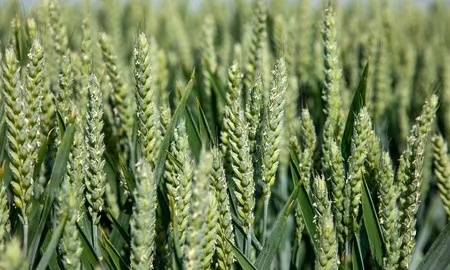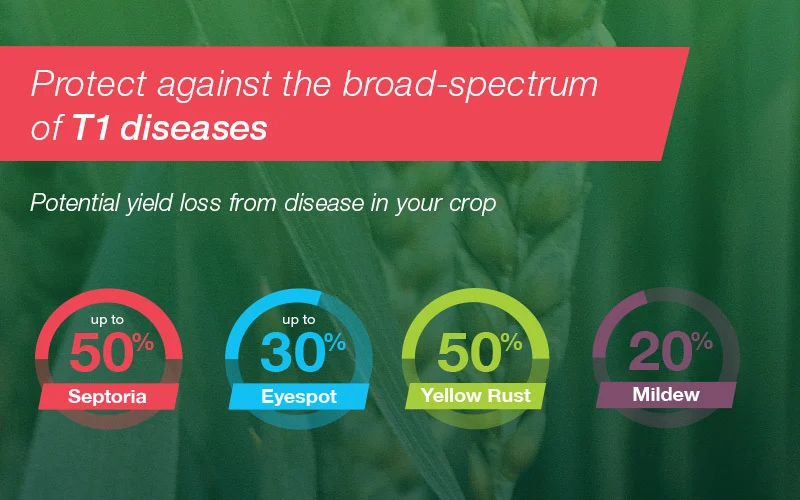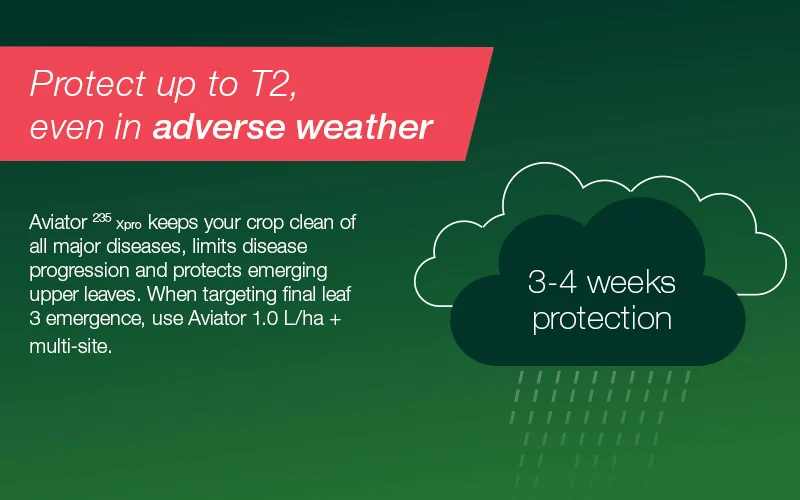
The spread of more aggressive pathogen populations, increases in operator workload and the loss of some once-relied-on active substances, achieving lasting disease control has become a more challenging and considered task. Below you’ll find lots of resources to support you in optimising your disease control programme.
Author
| 19th March 2021Tags
We Highly Recommend:
Fungicides
AscraXpro
Ascra® is a unique formulation of two SDHI fungicides – bixafen and fluopyram – and the broad-spectrum azole fungicide prothioconazole.
Read moreHow to maximise disease control and yield from your wheat fungicide programme
T1 Timing
Many diseases can damage your crop’s yield potential at T1. So it’s critical to get the timing right, and choose the best broad spectrum fungicide to keep your crop protected up to T2.
Potential yield loss from disease in your crop*:

Getting the timing right
A T1 spray applied too early usually results in poorer disease control on the emerging leaf 3, due to a lack of coverage on the leaf as it emerges after application. Whereas, a T1 application applied too late will leave leaf 3 exposed to infection for longer. As a result, any fungicide will need to work harder to control latent Septoria, and can have a negative impact on product efficacy.
This video gives advice on how to get the best out of using a T1 fungicide to control disease in wheat, as well as how to pinpoint the correct timing for T1, and fungicide choice in different scenarios.
Timing is important for T1 fungicides, so when should they go on?

For more videos on finding out more about maximising your wheat T1 strategy click here.
Other factors impacting T1 strategy
In this video, Gareth Bubb, commercial technical manager at Bayer and independent agronomist David Lines discuss how factors such as variety susceptibility and drilling date can impact your T1 strategy.
Does T1 strategy alter by variety susceptibility?

Identifying eyespot at T1
With many varieties in the Recommended List having an inherent weakness for eyespot, being able to identify the disease is key to control at T1.
In this video, Gareth Bubb, commercial technical manager at Bayer and independent agronomist, David Lines discuss how to identify the disease, and the weather conditions which may be conducive to its development.
How do you identify eyespot at T1?

Identifying leaf 3
The primary goal when applying a T1 fungicide is to control Septoria on the recently emerged final leaf 3 and leaf 4 at GS 31 – 32.
Richard Cromie, an independent agronomist, says there are 5 key steps to identifying leaf 3 for fungicide timings. To identify leaves:
Cut one layer at a time
Carefully peel back leaves
Discard outer leaves
Unroll all leaves to reveal the ear inside
Note leaf three must be fully emerged before T1 spraying
Watch Richard talk through his advice on identifying leaf 3 in the following video:
How to identify leaf three in winter wheat in 30 seconds

What fungicides to use at T1?
In most situations with the reduction in efficacy from straight azoles, the best disease control will come from a product containing both SDHI and azole active substances. It is important to keep the rates of azoles in the mix up to at least three-quarter dose to maximise disease control from that component, while also helping protect the SDHI from resistance development.
Bayer’s Aviator (bixafen + prothioconazole) and Ascra (bixafen + fluopyram + prothioconazole) are formulated to provide the correct ratio of SDHI to azole, making them sustainable and cost-effective options. They both have Bayer’s Leafshield formulation technology, which uses a unique combination of adjuvants to improve crop coverage, leaf penetration and movement of active ingredients within the leaf.
Ascra is a great option for T1 with good efficacy on all key disease including Septoria, Yellow rust and Eyespot. It can also reduce the need for a mildewicide. It offers good flexibility where you can adjust the dose rate to suit the circumstance. 1.0 L/ha will provide good control at T1 and it can be increased to 1.2 L/ha if there is an increased threat of disease.
Aviator is a cost-effective option on crops with lower disease pressure or where Eyespot is of particular concern due to the higher loading of PTZ.

Identifying latent disease
It’s important to know whether you have disease in the crop before you finalise your choice of fungicide at T1. But some diseases are hard to spot in their latent, or ‘non-visible’ stage. This is the period between a fungal spore landing on a leaf and germinating, and when disease is expressed on the surface of the leaf.
Septoria has a latent period of 15 – 18 days where you might not know whether disease is present.
We Highly Recommend:
Fungicides
AscraXpro
Ascra® is a unique formulation of two SDHI fungicides – bixafen and fluopyram – and the broad-spectrum azole fungicide prothioconazole.
Read moreT2 Timing
Winter wheat crops drilled in the early autumn will have been exposed to disease for longer than those sown later. This means that crops may be facing increased Septoria and Yellow rust pressure. However, the risk will vary depending on field-level factors such as varietal resistance, and what fungicides, if any, were applied at T0 and T1.
With earlier sown crops facing a potentially higher overall disease pressure, a fungicide providing broad-spectrum disease control, without a price premium, is likely to be the best choice at T2.
Ascra has proven itself over many seasons. The dose rate can be varied to match disease pressure, and as Ascra provides all-round disease control, with both protective and curative activity, it’s a simple one-can solution for your T2 spray.
Optimising your T2 spray
A T2 spray should be applied up to 4 weeks after the T1 spray, when the flag leaf has fully emerged. The primary objective of the T2 spray is to protect the top two leaves of the plant from major disease concerns such as Septoria and rust, during the key yield building growth stage.
The top 3 leaves can represent up to 80% of the plant’s final yield, and so the importance of the T2 spray is clear.
Succinate dehydrogenase inhibitor (SDHI) + azole fungicides are ideally suited to the T2 spray, combining disease control and yield building benefits.
How to get the most out of your T2 spray in winter wheat

Justifying fungicide choice
The T2 timing is critical to protect the yield potential of the crop, so making the right fungicide choice is important.
If you don’t know that you have Septoria in your crop, you might find it difficult to justify a more expensive fungicide with curative activity.
Tissue analysis can help to justify fungicide choice by identifying any latent ‘non-visible’ Septoria and Yellow rust in the crop. If you know you have disease in the leaf tissue, you can choose the most appropriate fungicide to control disease and continue to protect the crop from future infection.
T3 Timing
At T3 the primary objectives are to control Fusarium and top up foliar disease control. Fusarium can reduce grain quality and final yield by as much as 10%, and is typically worst in years when conditions are humid and characterised by frequent showers during flowering.
Most experts suggest mycotoxin control is a necessity for both premium and feed wheat markets, although Fusarium conditions are not conducive to spraying operations which can cause timing challenges at the T3 application.
The following video discusses why it is important to consider both milling and feed wheat at T3.
Do I need to focus on milling wheat and feed wheat at T3?

Optimising T3 timing
The optimum timing for hitting Fusarium is GS 61-63, when the first few anthers have emerged, but not too many are present. Fungicides have a narrow window of opportunity to control Fusarium at T3 – typically three days before or after the optimum.
The following videos contain useful information on the correct T3 timing, including an in-field demonstration of varieties not at the correct timing for T3, and discussion on how ear emergence does, or does not, correlate with flowering.
What is the correct T3 timing?

Does ear emergence always correlate to flowering starting?

Within a whole crop of wheat there are likely to be a range of different growth stages represented, however the important consideration is the average growth stage of the crop canopy, as Simon Edwards, Professor of Plant Pathology at Harper Adams University explains in the following video.
What should you look for when thinking about applying a T3 spray?

Fungicide choice at T3
There is a limited choice of T3 fungicides with activity against Fusarium, all of which are azoles. Proline has been shown to have the greatest activity and also provides a broader window of control.
What products should I use at T3?
